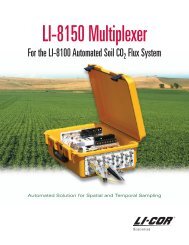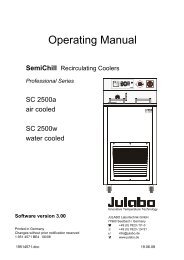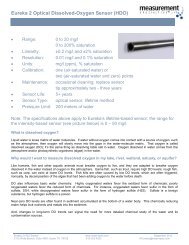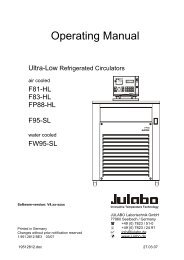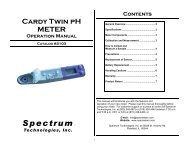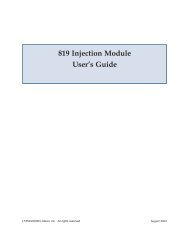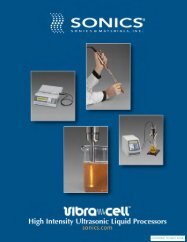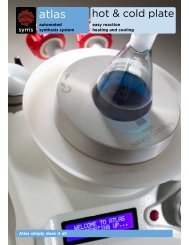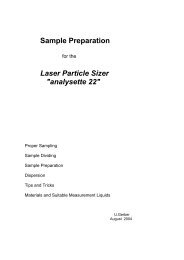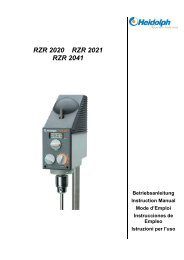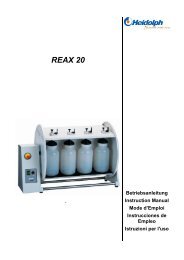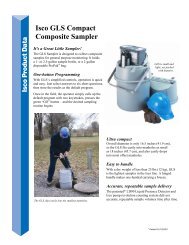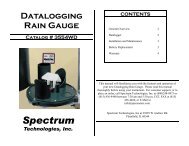FC 203B Fraction Collector Quick Reference Guide (PDF)
FC 203B Fraction Collector Quick Reference Guide (PDF)
FC 203B Fraction Collector Quick Reference Guide (PDF)
You also want an ePaper? Increase the reach of your titles
YUMPU automatically turns print PDFs into web optimized ePapers that Google loves.
Gilson <strong>FC</strong> <strong>203B</strong><br />
<strong>Fraction</strong> <strong>Collector</strong><br />
<strong>Quick</strong> <strong>Reference</strong> <strong>Guide</strong><br />
LT1732/©2005 Gilson, Inc. All rights reserved September 2005
<strong>FC</strong> <strong>203B</strong> <strong>Quick</strong> <strong>Reference</strong> <strong>Guide</strong><br />
Table of Contents<br />
page<br />
Notable Features of the <strong>203B</strong> ...................................................... 2<br />
Key Controls .................................................................................. 4<br />
“Hard” keys ................................................................... 4<br />
“Soft” keys ..................................................................... 6<br />
Cycle Collection ............................................................................ 9<br />
Collection Modes ........................................................................ 10<br />
Racks ............................................................................................ 13<br />
Input/Output Control ................................................................. 15
This <strong>Quick</strong> <strong>Reference</strong> <strong>Guide</strong> provides a concise overview of the<br />
operating features of the fraction collector. In most cases, this is<br />
the only documentation you will need to operate your fraction<br />
collector.<br />
Note: This <strong>Guide</strong> does not detail installation procedures! Before<br />
operating the fraction collector, refer to Chapter 2, Installation in<br />
the User’s <strong>Guide</strong> to make all necessary plumbing and electrical<br />
connections.<br />
Use the <strong>Quick</strong> <strong>Reference</strong> <strong>Guide</strong> to find out about:<br />
• control keys<br />
• operating modes<br />
• programming<br />
• available racks<br />
• input/output control<br />
For more detailed information, refer to the User’s <strong>Guide</strong>. It contains<br />
instructions about:<br />
• choosing run parameters<br />
• making plumbing and electrical connections<br />
• setting collection windows to selectively save or discard effluent<br />
• programming the fraction collector to control another device<br />
• using hidden function keys to set parameter values and to<br />
monitor fraction collector performance<br />
• maintaining and troubleshooting your unit<br />
If you need assistance, please contact your Gilson representative or<br />
if you are in the United States call the Gilson Customer Service<br />
Department at 800-445-7661 or 608-836-1551. You can also contact<br />
the Gilson Customer Service Department via its e-mail address:<br />
service@gilson.com. Specific contact information can be found on<br />
the Gilson web site at www.gilson.com.<br />
1
Notable Features of the <strong>FC</strong> <strong>203B</strong> <strong>Fraction</strong> <strong>Collector</strong><br />
How the<br />
fraction<br />
collector<br />
collects<br />
Racks<br />
How to<br />
operate<br />
You can choose from several collection modes:<br />
time, drop, peak plus time, peak plus drop, or<br />
manual. See Collection Modes for more.<br />
You can choose from a variety of racks. Each rack<br />
has a code number. Tell the fraction collector<br />
which rack you are using by entering the rack<br />
code number. When you change racks, simply<br />
enter the new code. See Racks for more.<br />
The fraction collector has two kinds of controls:<br />
• “hard” keys, such as START, END, YES, NO.<br />
The functions of these keys do not vary.<br />
• “soft” keys, the four white keys below the<br />
display. The functions of the soft keys vary<br />
depending on the current display. The<br />
current function of each soft key appears on<br />
the display directly above the key.<br />
See Key Controls for more.<br />
Memory<br />
2<br />
The fraction collector remembers your last set of<br />
instructions (e.g., the operating mode and the<br />
numerical values you assigned to the various<br />
options) even if the power has been turned off. It<br />
always “wakes up” ready to do exactly what it<br />
did the last time.<br />
At each startup, you should check the list of<br />
current values, to make sure they fit your needs. To<br />
check the values in the current mode, press List.
HELP<br />
Cycle<br />
Collection<br />
Collection<br />
Windows<br />
This hard key provides on-line instruction,<br />
during setup or during a run. Whenever you’re in<br />
doubt or need assistance, press the HELP key.<br />
The fraction collector enables you to collect fractions<br />
from each sample into the same set of tubes or<br />
into a new set of tubes.<br />
Collection windows allow you to collect only the<br />
effluent you want and to discard the rest. You can<br />
build up to ten collection windows. Collection<br />
windows are useful for:<br />
• excluding void volumes<br />
• excluding equilibration or washing volumes<br />
• aiding in selective peak collection<br />
Remember four key points about collection<br />
windows:<br />
• You can always collect from start to end,<br />
designating the entire collection period as<br />
one collection window.<br />
• Whenever the fraction collector is outside a<br />
collection window, it automatically diverts<br />
the effluent to drain.<br />
• At the start of each collection window, the<br />
dispense head automatically advances to the<br />
next tube.<br />
• The collection windows are not mode<br />
specific. Windows that you create in one<br />
mode are active in all other modes.<br />
3
Key Controls<br />
“Hard” keys<br />
START<br />
END<br />
Key used to start collection. This key has the same<br />
function as the Start soft key. You can also start the<br />
fraction collector remotely; see your User’s <strong>Guide</strong>.<br />
A manual override key that ends the collection and<br />
returns the dispense head to the “home” position at<br />
the left and rear of the unit. Typically, the dispense<br />
head will return to “home” after collecting into the<br />
last tube in the rack.<br />
When using the multiple column option, you must<br />
press END after the last fraction has been collected.<br />
If you press END while viewing any display, the<br />
ready-to-run display of the current mode will appear.<br />
You can then begin to collect fractions.<br />
EDIT<br />
HELP<br />
Key that calls up the display you use to select or<br />
change collection modes. To access advanced<br />
technical and service options, press EDIT 1, 2 or 3.<br />
See Appendices B, C and D in the User’s <strong>Guide</strong> for<br />
more information about those options.<br />
Displays information and instructions to simplify<br />
operation during setup or during a run. There are<br />
many help messages. Each gives specific information<br />
about your current options.<br />
4
ADV<br />
Manually advances the number of the current collection<br />
vessel. The current tube number is always shown on the<br />
display. For instance, if tube 1 is the current collection<br />
vessel, pressing ADV makes tube 2 the current collection<br />
vessel. When using the multiple column option, the<br />
current fraction number, rather than tube number, is<br />
displayed.<br />
Typically, tube advance is automatic, but you can<br />
always manually initiate an advance by pressing ADV.<br />
You can also advance remotely, as described in your<br />
User’s <strong>Guide</strong>.<br />
To understand the interaction between the ADV and<br />
DRAIN keys, see DRAIN.<br />
DRAIN<br />
Diverts effluent to drain. DRAIN is a two-state key.<br />
Press it once, its light goes on and effluent is diverted<br />
to drain. Press it a second time, the light goes off and<br />
the fraction collector collects into the current vessel.<br />
Whenever the dispense head of the fraction collector<br />
travels from a vessel to the drain trough or back<br />
again, it avoids passing over any vessel into which<br />
you have collected, to prevent contamination of<br />
collected fractions.<br />
While the fraction collector is draining, pressing ADV<br />
does not resume collection. Instead it advances the<br />
number of the current tube, which is always displayed<br />
during a run. When DRAIN is pressed a second time,<br />
the fraction collector collects into the vessel shown on<br />
the display. This gives you maximum flexibility: after<br />
draining, you could resume collection in the last vessel,<br />
the next one, or the first vessel in the next row. 5
0–9 Press number keys to enter numerical values. The<br />
decimal point, where applicable, does not have to be<br />
entered.<br />
One easy way to enter a new number is to press the NO<br />
key to clear the current number; then enter the new<br />
number in the same order you would write it on a piece<br />
of paper. Numbers appear on the display at the far<br />
right, and move to the left with each successive entry.<br />
YES<br />
NO<br />
Press YES when you want the instructions shown on<br />
the top line of the display to apply. The YES key has<br />
the same function as the Ok soft key.<br />
Press NO to clear the numerical value from the<br />
display. Also used to choose alternate options (e.g.,<br />
programmable output 2).<br />
“Soft” Keys<br />
The following functions are controlled by the four white keys on<br />
the fraction collector front panel. Directly above a soft key you’ll<br />
see its current function. If the display above a key is blank, that<br />
key is inactive.<br />
Add<br />
Press to begin building a collection window. After<br />
you press Add, specify the start and end times of the<br />
window. When the fraction collector is outside a<br />
window, all effluent will be discarded.<br />
Collection windows are optional. You may add up to<br />
10 windows. See Collection Windows in the User’s<br />
<strong>Guide</strong> for detailed instructions.<br />
6
Collect<br />
Cycle<br />
Del<br />
Delayed<br />
Adv<br />
Discard<br />
Drop<br />
Back<br />
List<br />
Press to collect the non-peak effluent in peak modes.<br />
Collection of non-peak material is optional. You can<br />
set a different time/tube or drop/tube value for<br />
collection of non-peak effluent than for collection of<br />
peak effluent. See Discard.<br />
Identifies the next set of tubes to be used for collection.<br />
This soft key appears instead of the Start soft key if the<br />
Tubes per cycle parameter was set to a number greater<br />
than 0 (zero). See Cycle Collection in the User’s <strong>Guide</strong><br />
for detailed instructions.<br />
Press to delete the collection window currently<br />
shown on the top line of the display. To collect from<br />
Start to End, delete all collection windows. See<br />
Collection Windows in the User’s <strong>Guide</strong> for detailed<br />
instructions.<br />
In manual mode, this key functions like ADV, except<br />
tube advance is delayed to account for the time it<br />
takes effluent to pass from the detector to the fraction<br />
collector.<br />
In peak modes, press to divert the non-peak effluent to<br />
the drain.<br />
Specifies collection in drop mode. See Collection<br />
Modes for more.<br />
After viewing a HELP message, press this key to<br />
return to the point at which you requested HELP.<br />
Press to display a listing of each option and its<br />
current value, in the selected collection mode.<br />
7
Manl<br />
More<br />
Ok<br />
Peak<br />
Quit<br />
Rack<br />
Start<br />
Time<br />
Specifies collection in manual mode. See Collection<br />
Modes for more.<br />
Press this key to see the next display of a HELP<br />
message. See Back.<br />
Indicates you want the instructions shown on the top<br />
line of the display to apply. Works in the same way as<br />
the YES hard key.<br />
Specifies collection in one of the two peak modes.<br />
After making this selection, you’ll be asked if you<br />
want to subfractionate peaks by time or by drop. See<br />
Collection Modes for more.<br />
Press to return to the previous display.<br />
Press to tell the fraction collector which rack you will<br />
use. You can change the rack code simply by entering<br />
a new number. Also calls up a description of the rack<br />
code that currently appears on the display. See Racks<br />
for more.<br />
Press to start the collection. The START hard key has<br />
the same function.<br />
Specifies collection in time mode. See Collection<br />
Modes for more.<br />
8
Cycle Collection<br />
The fraction collector enables you to collect fractions two different<br />
ways:<br />
• Collect each sample, or full collection cycle, into the same set<br />
of tubes. During the run, each cycle begins at tube 1.<br />
• Collect each sample, or full collection cycle, into a new set of<br />
tubes. During the run, each cycle begins at the tube following<br />
the last tube of the previous cycle.<br />
The Tubes per cycle parameter in the Technical menu (press EDIT 2)<br />
enables you to indicate which way you want the fractions<br />
collected.<br />
To collect each sample into the same set of tubes, set the Tubes per<br />
cycle parameter to 0 (zero).<br />
To collect each sample into a new set of tubes, set the Tubes per<br />
cycle parameter to a value other than 0 (zero). Using the tubes per<br />
cycle and the total tube capacity for the rack, the number of cycles<br />
is calculated. If the number of tubes per cycle can’t be divided<br />
evenly into the tube capacity for the rack, the number of cycles is<br />
the whole-number quotient; the remaining tubes are not used.<br />
See Chapter 3 in the User’s <strong>Guide</strong> for more information.<br />
9
Collection Modes<br />
Time For collection of timed fractions; from 0.01 to 99.99<br />
Mode minutes per tube, in 0.01 minute increments.<br />
Parameters:<br />
_ _ . _ _ min/tube<br />
Collect: _ _ _ . _ to _ _ _ . _ (collection windows)<br />
You can change min/tube values during the run.<br />
Enter new numbers; then press YES.<br />
Drop For collection of fractions by drop count; from 1 to 9999<br />
Mode drops per tube.<br />
Parameters:<br />
_ _ _ _ drops/tube<br />
Collect: _ _ _ . _ to _ _ _ . _ (collection windows)<br />
You can change drops/tube values during the run.<br />
Enter new numbers; then press YES.<br />
Manual<br />
Mode<br />
For manual collection. Use the START, ADV, DRAIN<br />
and END keys. A delayed advance soft key advances<br />
the dispense head only after waiting until the effluent<br />
passes from your detector to the fraction collector. See<br />
the User’s <strong>Guide</strong> for more information about when to<br />
activate the delayed advance function.<br />
10
Parameters:<br />
Delay time: _ . _ _ min<br />
Collect: _ _ _ . _ to _ _ _ . _ (collection windows)<br />
Peak<br />
Modes<br />
Choose to collect peak and/or non-peak fractions. To<br />
detect peaks, the fraction collector must be connected to<br />
an analog output of a detector. The fraction collector<br />
can interpret the detector data to distinguish peaks<br />
from non-peaks. See the User’s <strong>Guide</strong> to connect the<br />
detector to the fraction collector multipurpose I/O port.<br />
There is no peak-only mode. Peak or non-peak effluent<br />
must be subdivided either:<br />
• by time (from 0.01 to 99.99 min./tube) or<br />
• by drops (from 1 to 9999 drops/tube)<br />
In peak modes, the fraction collector needs the<br />
following information:<br />
• the width of a typical peak in your run at half of<br />
its maximum height, measured in minutes<br />
• the height of the shortest peak of interest,<br />
measured in millivolts (this number is easily<br />
determined from the full scale voltage deflection<br />
of your detector and recorder) or the millivolt<br />
(mV) level above which peaks will be collected<br />
• the time it takes for the effluent to pass from the<br />
detector flow cell to the dispense head of the<br />
fraction collector. This aids in the collection of<br />
purer peaks. Your User’s <strong>Guide</strong> shows you how to<br />
calculate the delay time based on your setup. 11
You can collect the non-peak effluent at a different<br />
time/tube or drop/tube than the peak effluent.<br />
To discard non-peak effluent to waste, choose the<br />
Discard soft key. When you discard non-peak effluent,<br />
it is highly recommended that you use a 3-way valve.<br />
See your User’s <strong>Guide</strong>.<br />
Parameters:<br />
Peak: _ _ . _ _ min/tube<br />
or<br />
Peak: _ _ _ _ drops/tube<br />
Non-peak: _ . _ _ min/tube<br />
or<br />
Non-peak: _ _ _ _ drops/tube<br />
Note: The “Non-peak” displays will not appear if<br />
you choose to discard non-peak fractions.<br />
Peak width: _ . _ _ min<br />
Peak height: _ _ . _ mV<br />
or<br />
Peak level: _ _ . _ mV<br />
Delay time: _ . _ _ min<br />
Collect: _ _ _ . _ to _ _ _ . _ (collection windows)<br />
You can change time/tube or drop/tube values<br />
during a run. Enter numbers; then press YES.<br />
12
Racks<br />
The fraction collector “knows” the collection patterns for all of the<br />
following racks, according to their code numbers. When you enter<br />
the code number of the rack you intend to use, the fraction<br />
collector describes the rack to you. To change rack codes, simply<br />
enter the code of the new rack.<br />
Collection plate<br />
Code 0 rack<br />
Code 1 rack<br />
Code 2 rack<br />
Code 4 rack<br />
Code 11 rack<br />
Code 14 rack<br />
Code 15 rack<br />
Code 20 rack<br />
Code 21 rack<br />
Code 23 rack<br />
80-cavity plate, 2.5 mL/cavity; will also hold<br />
11 mm Eppendorf vials. Set the rack code to<br />
“0”.<br />
for 80 12 mm diameter vials<br />
for 80 13 mm diameter tubes<br />
for 119 6 mm diameter tubes<br />
for 80 12 mm diameter tubes<br />
for 105 13 mm diameter tubes<br />
for 128 12 mm diameter tubes<br />
for one 96-well microplate. Set rack code to<br />
“15” to collect across rows. Set rack code to<br />
“17” to collect in a serpentine pattern.<br />
for 108 10 mm diameter tubes<br />
for 60 13 mm diameter tubes<br />
for forty-four 17 x 55 mm (6.8 mL) or<br />
17 x 65 mm (8 mL) mini-scintillation vials<br />
13
Code 23W rack for 44 Waters WISP vials. Set rack code to “23”.<br />
Code 24 rack<br />
Code 28 rack<br />
for quantity fourteen 28 x 57 mm scintillation<br />
vials (20 mL)<br />
for quantity one hundred eight 10 x 65 mm<br />
(3 mL) or 10 x 75 mm (3.5 mL) tubes<br />
Code 29 rack for quantity sixty 12 x 75 (5 mL) or 13 x 75<br />
(6 mL) tubes<br />
Code 29 LE rack<br />
Code 29 SE rack<br />
Code 30 rack<br />
for 60 11 mm Eppendorf vials. Set rack code to<br />
“29” if using vials without caps. If using<br />
capped vials, place vials in center two rows<br />
with caps facing outward, set rack code to<br />
“19”. (See Appendix A of User’s <strong>Guide</strong> for<br />
diagram.)<br />
for 60 8 mm Eppendorf vials. Set rack code to<br />
“29” if using vials without caps. If using<br />
capped vials, place vials in center two rows<br />
with caps facing outward, set rack code to<br />
“19”. (See Appendix A of User’s <strong>Guide</strong> for<br />
diagram.)<br />
thermostated rack for 60 12 mm diameter vials<br />
Code 30P rack polypropylene rack for quantity 60 12 x 32<br />
mm (2 mL) vials; 4 x 15 pattern<br />
Code 32 rack<br />
thermostated rack for 60 13 mm diameter<br />
tubes. When used with 13 x 65 mm tubes,<br />
mount rack on a thermostated rack holder<br />
and set rack code to “30”.<br />
14
Code 33 rack<br />
Code 33P rack<br />
thermostated rack for 14 28 mm diameter vials<br />
polypropylene rack for quantity fourteen<br />
28 x 57 mm scintillation vials; 2 x 7 pattern<br />
Input/Output Control<br />
Provides inputs for:<br />
• remote start/advance and end, by contact closure<br />
• analog signal from detector for peak detection and<br />
quantification<br />
Provides outputs for:<br />
• event mark on tube advance<br />
• programmable on/off control of pump, recorder, etc., by<br />
contact closure<br />
15
Your User’s <strong>Guide</strong> describes how to make the input and output<br />
connections and how to set the programmable output. The<br />
following table lists the functions of each pair of contacts.<br />
1–2 Analog input from detector. Used in peak modes.<br />
Pin 1 is signal (10–100 mV); Pin 2 is ground reference.<br />
3–4 Input A. When activated by contact closure, fraction<br />
collector will start a run or, if already in run, will advance<br />
to the next tube.<br />
5–6 Input B. When activated, collection will end and indexing<br />
head will return to home.<br />
7–8 Output 1. Sends a 0.1 second contact closure at each tube<br />
advance. Used to indicate an event on your recorder/data<br />
device.<br />
9–10 Output 2. User programmable contact closure. Timing of<br />
this contact closure is set in the Technical menu (press<br />
EDIT 2). See your User’s <strong>Guide</strong> to learn how to set this<br />
option. The factory default setting is “On after wait 1”.<br />
Also, Gilson Serial I/O Channel (GSIOC) port allows full-function<br />
computer control of the fraction collector. See your User’s <strong>Guide</strong> for<br />
details.<br />
16



